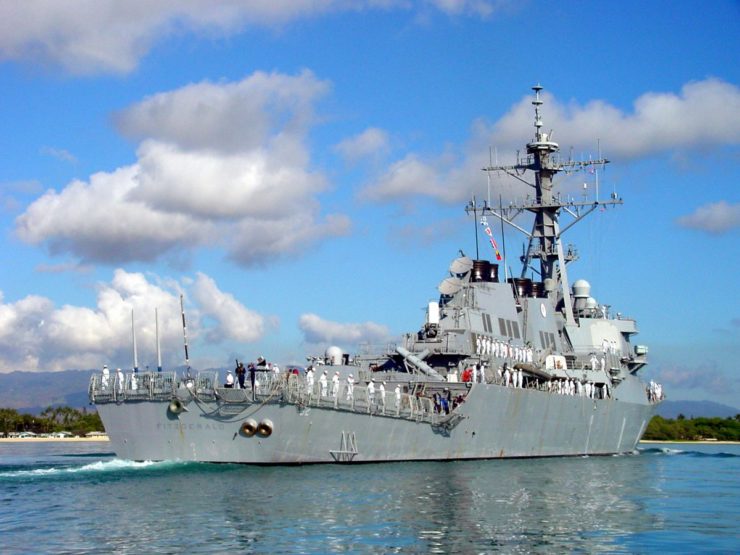
After more that two decades of absence of any visible interest towards the strategically critical point of the Pacific Ocean – the Philippines, Washington is doing its best to strengthen its influence over this picturesque archipelago. Even though the United States station thousands of troops stationed in a number of countries, among which one can name Japan, South Korea and Guam, Washington is seeking ways of expanding its presence in the region. This change occurred due to th e “renewal” of the US national strategy, which now strives to oppose China in the Southeast Asia. According to the unofficial statements made by the American military elite, the modern military doctrine of the United States is focused on the rivalry with China in the Sout China Sea, the East China Sea and the Yellow Sea.
The annual cargo traffic of the South China Sea is estimated to be around 5.3 trillion dollars, the US share in this is hovering around 1.2 trillion. No wonder that the United States are doing their best to secure this traffic.
The Americans are planning to dislocate 8600 marines from their military bases in Japan to Naval Base Guam, on the premise that the “transnational threats” are spreading. The harbour is to be under massive reconstruction since it should be able support carriers for as long as 63 days. At present the US military carriers can spend 16 days max at Guam. This reconstruction should cost the American taxpayers 7.4 billion dollars.
The United States have already signed an agreement with the Australian government to deploy US marines on the Australian soil. Second agreement has recently been signed with Singapore that will allow the construction of the new U.S. Naval base at its territory. Pentagon believes that the allocation of the United States Pacific Command controls centers to the Philippines and the increase in the number of US marines which should be justified by the numerous bilateral military exercises must allow Washington to considerably reinforce its positions in the region.
And these joint military training are taking place at the Philippines bases on a regular basis, for instance at the end of June the Cavite naval base saw the bilateral training of the Philippine and American soldiers, the latter trained their counterparts in launching the UAVs drones, that can be effectively used to seek and afterwards track ships in the Sout China Sea. One can judge the extent of the American military cooperation with the Philippines by the amount of times the American ships and submarines entered Subic bay. In the first five month of 2013 there were 72 “visits” which represents a steady grow from 2012 (88 per year) and 2011 (54 per year).
At the end of June the United States held a six days military training with its fellow Philippine allies in the South China Sea. UUS Fitzgerald and BRP Gregorio del Pilar along with five hundred sailors and marines from both sides took part in it. The exercices were conducted 50 miles away from the disputable territories that China claims to be its own. The target of this military training was “interceptions of the suspected enemy vessels, boarding and capturing of the materials that can bear potential threat to the allies”. The terms “enemy vessels” and “allies” hints the underwater reasons of these exercises. It’s curious that the previous bilateral trainings at see where simulating anti-piracy operations. Now-a-days the things have changed and the Americans are now prepare to fight Chinese navy.
Some of the American generals state rather straightforwardly that the new American military doctrine declares creation of numerous small scale military bases that should function in close cooperation with the “allies” of Washington. The old doctrine originated from the Cold War era, for the sake of comparison, declared that the each American base should be of colossal proportions with large numbers of troops stationed at every time..
This “cooperation” can be clearly seen if you are to read the news carefully. On June 27 the Japanese Defense Minister Itsunori Onodera visited the Department of National Defense Headquarters in Quezon City where he met his Philippines counterpart Voltaire Gazmin. At the press conference held after the meeting the two defense ministers shared their concerns over the “increasingly aggressive” Chinese expansion in the region. Both Tokyo and the Manila have territorial disputes with China, this was the reason behind their mutually positive attitude towards the growing presence of the United States in the region. They also confined to the members of the press that they’ve managed to discuss the possibilities of the Japanese forces being “temporary stationed” at the Philippines.
This step can only mean Japan is to be reborn in the capacity of the global imperial state. The militarization of the contemporary Japan is inspired by the United States which perceives the Philippines as their trump card in the future game. One can remember the statement that the Philippine Foreign Secretary Albert del Rosario made in an interview to Financial Times in 2012 that Manila would support the scrapping of the so-called pacifist clause in the Japanese constitution, which has inhibited Japanese re-militarization, citing tensions with China as the justification.
The curious fact is that the stationing of foreign troops at the Philippine soils is unconstitutional at this archipelago. This part of the supreme law has been properly ignored by the Philippine authorities for a while now, since they claim that they provide the foreign troops with a “guest presence’.
The United States can boast 750 bases around the global, which equivalences to 95% of all the military bases in the world. Can a “truly democratic society” as the Washington preachers love to label their country posses that amount of excessive force that is not needed for self defense. Does they posses any moral right to blame Iraq, Libya and Syria for suppressing somebody? It’s true that the one at fault always is the one who blames.
Vladimir Odintsov is a political columnist. Exclusively for New Eastern Outlook.
